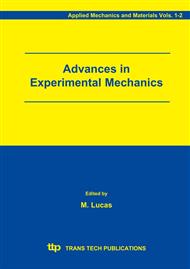p.93
p.99
p.107
p.113
p.121
p.127
p.133
p.139
p.147
The Effect of Crack-Tip Interactions on the Curve-Fitting of Isopachics
Abstract:
Recent work by the authors has allowed the estimation of crack-tip SIFs by direct curvefitting of a cardioid form to measured isopachics from thermoelastic stress analysis. However, some of the curve-fits indicated that the cardioid form was inappropriate for the base model. One of the possible explanations for this is that the cardioid form is only suitable for an isolated crack-tip stress field. In the experimental data for the previous studies, a crack was placed centrally in a plate and there will therefore have been two (potentially) interacting crack-tips involved. The object of the current paper is to determine numerically, the stress field for such a crack system and to quantify the effect of any interactions on the curve-fitting procedure.
Info:
Periodical:
Pages:
121-126
Citation:
Online since:
September 2004
Authors:
Price:
Сopyright:
© 2004 Trans Tech Publications Ltd. All Rights Reserved
Share:
Citation:


